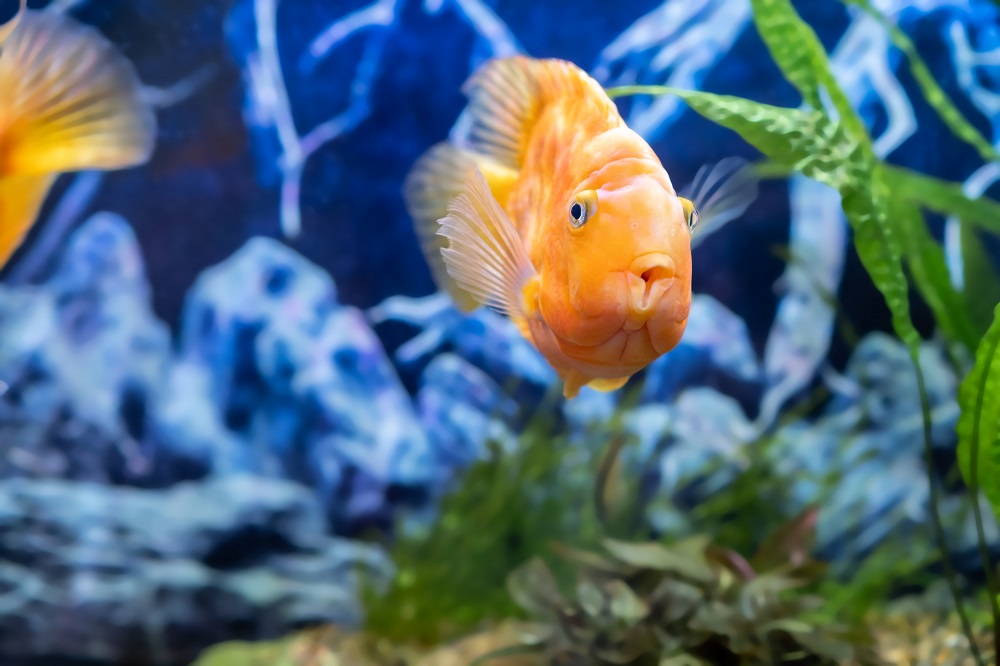Check out these tips for buying an aquarium backed by pet experts!
Buying an aquarium can be an exciting step, whether you’re a beginner looking to keep a few colorful fish or a hobbyist ready to dive deeper into aquatic life.
However, before you start adding fish to your cart, it’s essential to know that aquariums require more than just water and decorations—they demand careful planning, patience, and the right setup. Here are 7 key tips for buying an aquarium you need to know before bringing home your new finned friends.

Choose the right tank size for your space and experience
One of the biggest mistakes new aquarium owners make is buying a tank that’s too small. You might think a smaller tank is easier to manage, but it’s the opposite.
Smaller tanks are more vulnerable to temperature swings, chemical imbalances, and overpopulation. For beginners, a tank in the 20- to 30-gallon range is often ideal. It’s large enough to provide a stable environment but still manageable in size and cost.
Here are a few things to consider when choosing a size:
One of the first tips for buying an aquarium is to consider your space: Measure the area where the aquarium will go. Make sure it can support the weight of a full tank (a gallon of water weighs about 8.3 pounds).
Then check how much you’re willing to spend on it: Larger tanks cost more upfront and require more equipment and energy. Then, what type of fish do you want to have? Bear in mind that some species require more room to swim or need to live in schools. Do your homework!
Bonus Tip: Glass aquariums are heavier but more scratch-resistant, while acrylic tanks are lighter and clearer but can scratch easily.
Pick the right location before you buy
I know it may sound weird, but one of the best tips for buying an aquarium is to make sure it fits in the designated space. Aquariums are not easy to move once they’re set up, so pick your location wisely.
Avoid areas near windows, vents, or places where temperatures fluctuate. Direct sunlight can cause algae overgrowth, while cold drafts can chill the water.
A good spot is: out of direct sunlight, close to a power outlet, on a sturdy, level surface, and of course, away from high-traffic areas (to avoid bumping or stressing the fish).
Also, keep in mind that tanks can splash, leak, or overflow during maintenance, so placing them on carpet might not be the best idea.
Understand filtration systems and why they matter
Among all the tips for buying an aquarium that you should keep in mind, filtration is one of the most important parts of a healthy aquarium. Your filter does three key jobs: mechanical filtration because which removes debris and waste. Secondly, the chemical filtration removes toxins and odors (usually using activated carbon).
And thirdly, the biological filtration promotes healthy bacteria that break down ammonia and nitrites from fish waste. When buying an aquarium, don’t skimp on the filter. It needs to be powerful enough to cycle the tank’s water several times per hour.
A good rule of thumb: your filter should process the entire volume of the tank 4–6 times per hour. For example, a 30-gallon tank should have a filter rated for 120–180 gallons per hour (GPH).
Plan for cycling your aquarium (Don’t Skip This!)
A common beginner mistake is adding fish immediately after setting up the tank. That’s a fast track to disaster. Before adding any fish, you need to cycle your aquarium, which means allowing beneficial bacteria to grow and stabilize the water chemistry. This process, known as the Nitrogen Cycle, can take 2–6 weeks, depending on the method.
During this time, you’re building colonies of bacteria that convert ammonia to nitrate, making the water safe for fish.
You can cycle your tank with: fish food (which decays into ammonia), pure ammonia, “seeded” media from another established tank.
Don’t forget to test your water frequently using aquarium test kits. Only add fish once ammonia and nitrite levels are zero and nitrates are present.
Choose fish species that match your tank and skill level
Not all fish are beginner-friendly. Some need pristine water, others are aggressive, and some require specific tank conditions. When choosing fish, always consider: your tank size, the water temperature, and pH, and fish temperament (peaceful, semi-aggressive, or aggressive). Oh, and don’t forget to read everything about the type of fish you want to buy.
Trust me when I say that this is one of the best tips for buying an aquarium that should help you have a safe space for your fish. While some of them prefer being alone, others can die without company, while others can be very aggressive in the presence of others. Make sure you pair your pet fish accordingly!
Great beginner fish include:
• Guppies
• Neon Tetras
• Zebra Danios
• Platies
• Corydoras catfish
Avoid fish that grow too large, have complicated care requirements, or are incompatible with others. When in doubt, consult an aquarium specialist or do species-specific research.
Budget for more than just the tank
A couple of years ago, an aquarium specialist told me something that I will always cherish: make sure you have a stretched budget for more than just the tank and the filters. A common surprise for first-time buyers is that the tank itself is just one part of the cost.
Since I am here to help and support my readers, after talking to various aquarium specialists, here’s a list of essentials you’ll need:
• Tank ($50–$200+ depending on size)
• Filter ($20–$100)
• Heater (if tropical fish – $15–$50)
• Lighting ($30–$100, especially for planted tanks)
• Substrate (gravel, sand, etc.)
• Water conditioner (to remove chlorine)
• Test kits (ammonia, nitrite, nitrate, pH)
• Fish food
• Decor/plants/hiding places
• Net, siphon, algae scraper, and other tools
And don’t forget to budget for ongoing costs like electricity, water, replacement filter cartridges, and potential medications.

Patience is key, so never rush the process
This might be the most important tip of all. Aquariums are ecosystems, not decorations—and ecosystems take time to balance.
New hobbyists often make the mistake of overstocking, feeding too much, or adding incompatible fish too soon. These missteps can lead to algae blooms, stressed fish, or even tank crashes.
Go slow and:
• Add fish gradually, spacing introductions over several weeks
• Feed sparingly—most fish only need a small amount once or twice a day
• Test water regularly, especially in the first few months
• Perform regular water changes (20–30% weekly is a good target)
Taking your time ensures your fish live longer, healthier lives—and you’ll avoid costly mistakes.
Bonus tip: Consider freshwater before saltwater
Saltwater tanks are beautiful but much more demanding. If you’re new to fishkeeping, start with a freshwater aquarium. They’re more forgiving, require fewer chemical additives, and have a wider variety of hardy fish.
Once you gain experience, you can branch into more complex setups like: heavily planted tanks, cichlid tanks, and reef tanks (saltwater with coral).
Final thoughts: set yourself up for success
I really hope that these tips for buying an aquarium will help you! Buying an aquarium can be incredibly rewarding, but success starts with planning.
By keeping these 7 key tips for buying an aquarium you need to know in mind, you’ll avoid common beginner pitfalls and build a healthy, thriving aquatic environment from day one.
Whether you dream of colorful guppies or a peaceful aquascape, the key is to stay informed, go slow, and enjoy the journey. Your future pet fish will thank you for it!
You’re still unsure about what filters, fish, and other things you need to start everything on the right path? I got you! The book Community Fish (CompanionHouse Books) Choosing Starter Freshwater Fish, Aquarium Setup, Feeding, Breeding, Compatibility, Peaceful Species, Aquascaping, Water Quality, Health Care, and More will be your friend in need in this matter.
You may also be interested in: 8 Intelligent Pet Birds That Are Easy to Train.












